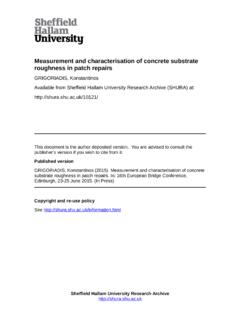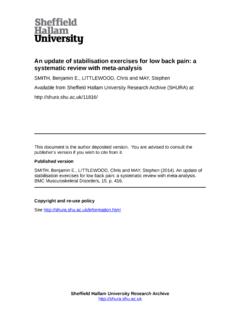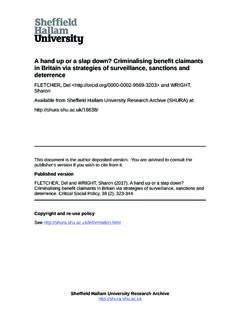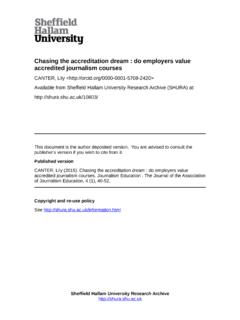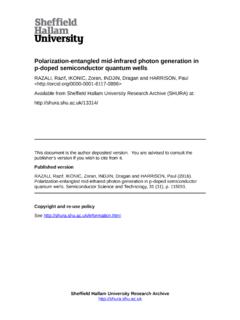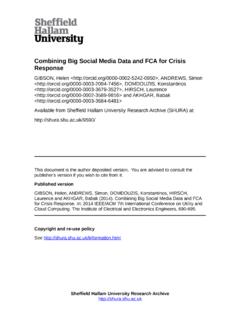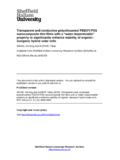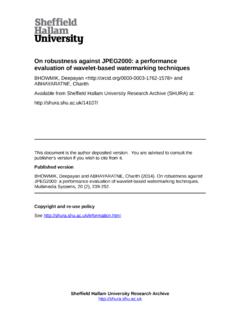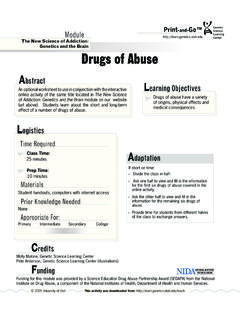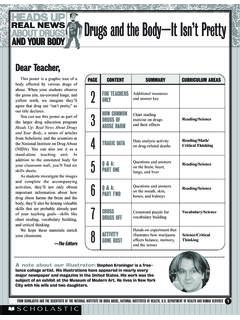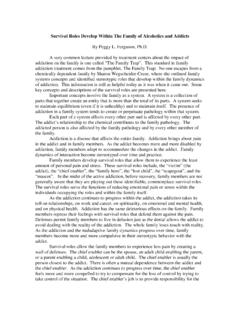Transcription of Long term recovery from addiction : criminal justice ...
1 1 1 Long-term recovery from addiction : criminal justice involvement and positive criminology ? Abstract The positive criminology perspective looks at positive life influences that distance individuals from offending, and enable the growth of personal and social strengths. Within a recovery model for alcohol and drug addiction , as part of a strengths-based approach to understanding sustainable change, recovery capital is the currency for measuring the personal and social resources available to achieve and sustain change, and the community factors that help or hinder these efforts (sometimes referred to as community capital). However, it has been argued that adverse experiences, particularly chronic mental health and serious criminal recidivism, are barriers to change, and constitute negative recovery capital.
2 Based on secondary analysis from the Glasgow recovery Study, and two other studies of pathways to recovery , this chapter examines the impact of prison history on recovery outcomes. The paper concludes that a better than well model of change can explain the rebound effect from serious adverse life events. This is embedded within a social identity model of recovery transformation, which fits well with the positive criminology perspective of personal transformation in developing a new non-offending identity. 2 2 1. The emergence of an addictions recovery movement positive criminology has recently been put forward as a perspective that can incorporate a range of theories and models which emphasise positive experiences that may potentially prevent or discourage continued criminal behavior (Ronel and Elisha, 2011 ).
3 Across a range of disciplines a strengths based model has become increasingly prominent (Ronel and Elisha, 2011), building on the work of positive psychology (Seligman, 2002), asset-based community development models ( McKnight and Block, 2010) and the emergence of a recovery movement in mental health ( Slade, 2009), alcohol and drugs (White, 2009; Best, 2012) and criminal justice (Ronel and Elisha, 2011). In both mental health and the addictions field this has represented a significant paradigm shift and so the slow emergence of a supporting literature. Humphreys and Lembke (2013) have argued that there are three areas of solid empirical support for a recovery model in addiction around the importance of recovery housing, around the positive role of the mutual aid groups, in particular the 12-step fellowships, and around peer-based delivery of interventions.
4 Nonetheless, there is a very limited evidence base about what recovery looks like (UKDPC, 2007) and about the pathways and predictors of successful recovery from substance addiction (Hser, Longshore and Anglin, 2007). Laudet and White (2010) looked at the priorities of 356 individuals in drug recovery (both heroin and crack cocaine) in New York City and argued that services should not focus on abstinence alone and that services ought to aim to give clients the necessary resources and strategies to achieve enhanced quality of life and improved functioning and to assume responsibility. In other words, symptom reduction is critical but it is a means to an end (Laudet and White, 2010, ). The resources and strategies described in the recovery literature fit well within a positive criminology perspective, in that the focus is not on addressing deficits but on building resources and strengths and switching the focus from professionals to community and peer based models and interventions.
5 In one of the few UK studies to focus on experiences of recovery , conducted with former heroin users in long-term recovery , Best and colleagues (2008) found that what enabled former heroin users to maintain their recovery was largely about moving away from substance using peer networks and developing appropriate 3 3 recovery support networks. More recently, Best et al. (2011) conducted an assessment of quality of life in 205 former alcoholics and heroin addicts in Glasgow (the Glasgow recovery Study) and found that higher quality of life was associated with a longer duration of recovery , but also with current lifestyle factors. Those who reported spending more time with other people in recovery and those more actively involved in a range of activities (parenting, volunteering, education, training and employment) reported significantly greater quality of life.
6 The promotion of rehabilitation through self-help groups has been cited as an example of social acceptance within the positive criminology perspective (Ronel and Elisha 2011), and is consistent with an emphasis on an increasing role for peers and social networks in the journey to rehabilitation. Hibbert and Best (2011) have linked the recovery process to quality of life in a study of 53 recovering alcoholics in Birmingham, England, and have reported that quality of life growth continues as an ongoing process in recovering drinkers. Their results are also significant in that they suggest particularly strong growth in recovery around social and environmental aspects of quality of life measurement in those in long-term recovery , and that this growth may exceed general population levels of quality of life generating the idea that recovery may not be about remission to a normal state but rather a transcendence to a state that can be characterised as better than well.
7 However, much of the ongoing debate has revolved around what we mean by recovery with each of two consensus group definitions (UKDPC, 2007; Betty Ford Institute Consensus Panel, 2007) suggesting three elements to recovery Wellbeing, Sobriety, and Citizenship. There has also been increasing interest in the epidemiology of recovery with White (2012), based on a population survey in South-eastern Pennsylvania, estimating that of the adult population are in recovery from a substance abuse history (other than tobacco). In a separate review of 415 scientific reports on recovery rates published between 1868 and 2011, White (2012) concluded that of adults surveyed in the general population who once met lifetime criteria for substance use disorders, an average of ( in studies conducted since 2000) no longer met those criteria at the time of the survey.
8 Therefore, it is estimated that around half of all those who have a lifetime addiction problem will eventually achieve recovery , but there is relatively little research indicating who will fall into either the successful or the unsuccessful 4 4 categories, but this is based on a narrow definition of recovery focused primarily on the disappearance of active symptoms of addiction . Ronel and Elisha (2011) have called for an increased focus for research on factors which are experienced as positive and distance an individual from crime, and this is consistent with attempts to measure the size of the in recovery population and their pathways out of addiction and/or offending. 2. recovery capital and negative recovery capital While there is increasing evidence that people can overcome addictions, the mechanisms that enable that transition are much less clearly understood or articulated, and this parallels similar questions raised about pathways to offending desistance by Maruna (2001).
9 One suggestion for conceptualising the transition from active addiction to recovery is in terms of recovery capital (Granfield and Cloud, 2001). recovery capital has its origins in the concept of social capital defined as connections among individuals social networks and the norms of reciprocity and trustworthiness that arise from them (Putnam, 2000, ). There are two main types of social capital which are often described as bridging and bonding capital. Bonding social capital relates to the values of social and emotional support and reciprocity which is generated within similar groups and communities. Bridging social capital refers to information sharing and acquisition generated through external networks and sources. In its initial articulation in the addictions field, Granfield and Cloud (2001) suggested that recovery capital exists on a scale with both positive and negative sides where positive elements strengthen and support a person s recovery and negative elements obstruct it.
10 In this model, there are four types of recovery capital social capital, cultural capital, physical capital and human capital. It is people s strengths and assets which are likely to predict long term change, rather than measures of problems and deficits (White and Cloud, 2008), although this has been subjected to almost no empirical research. White and Cloud have argued that the transition to a recovery model will involve our capacity to measure the growth of strengths and resources, and to map their changes over time in the same way that we have measured changes in symptoms and pathologies to quantify gains in acute treatment services. Groshkova, Best and White (2012) have since published the Assessment of recovery Capital (ARC) as a metric of recovery progress as part of that commitment to developing a science of recovery .
